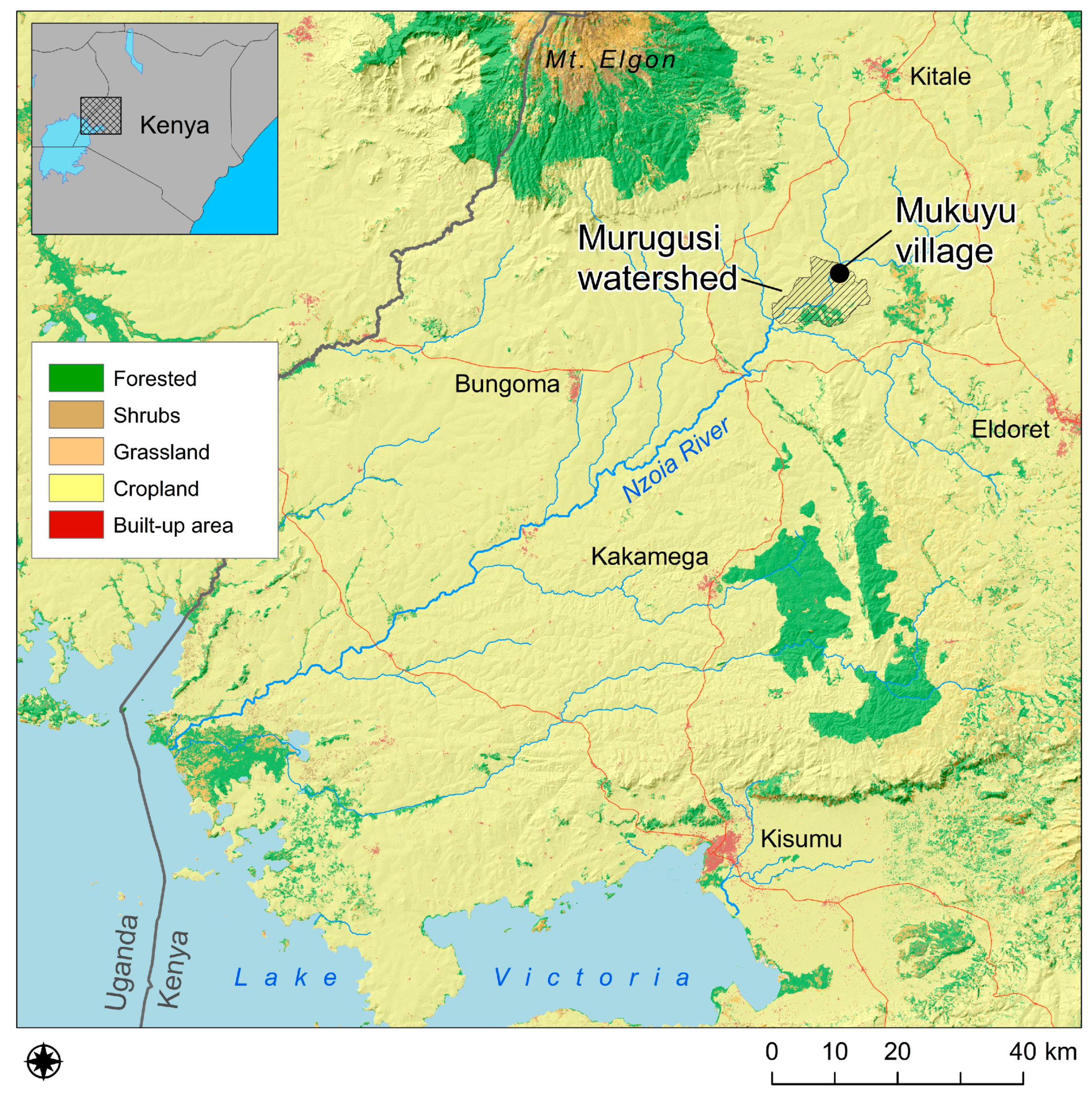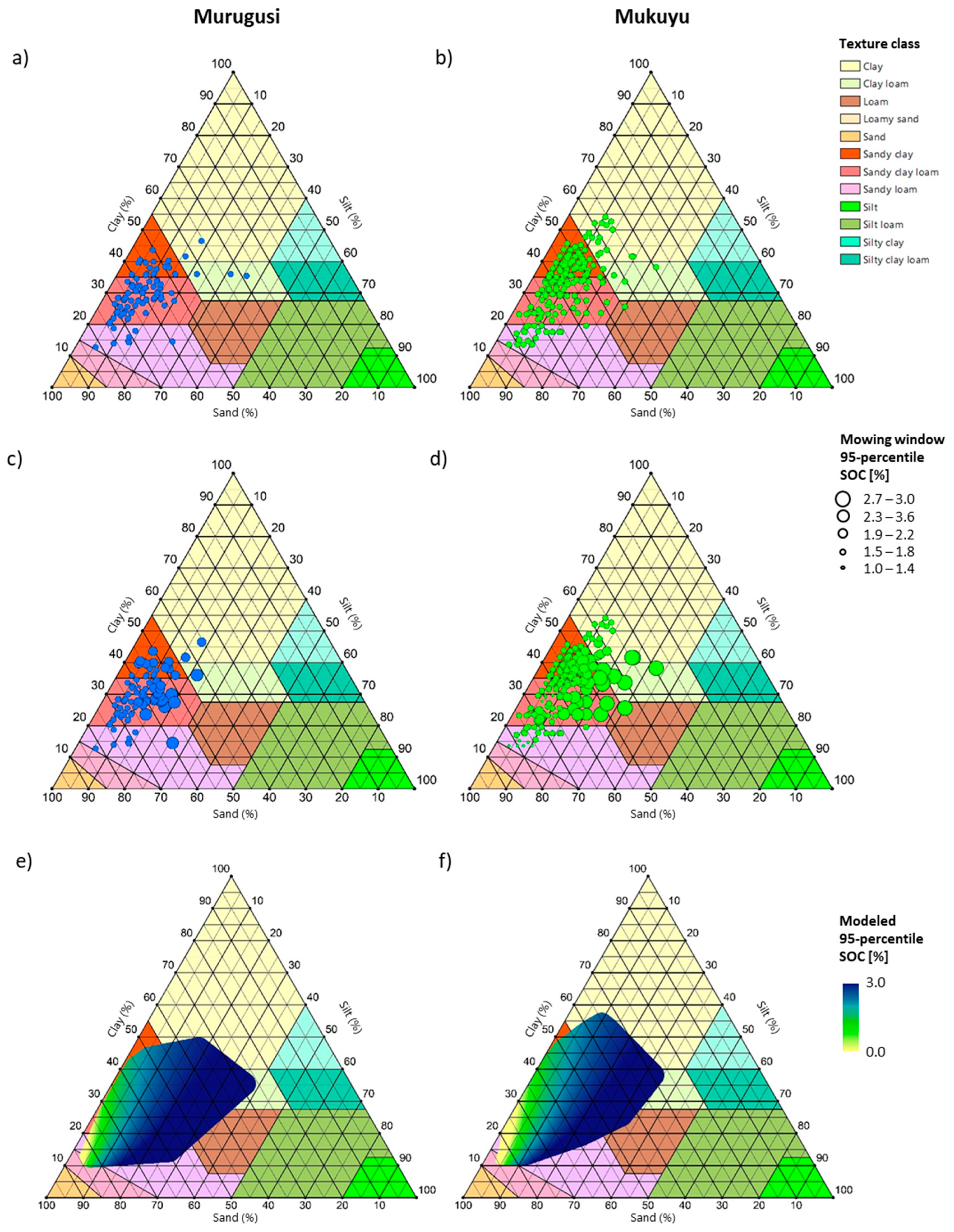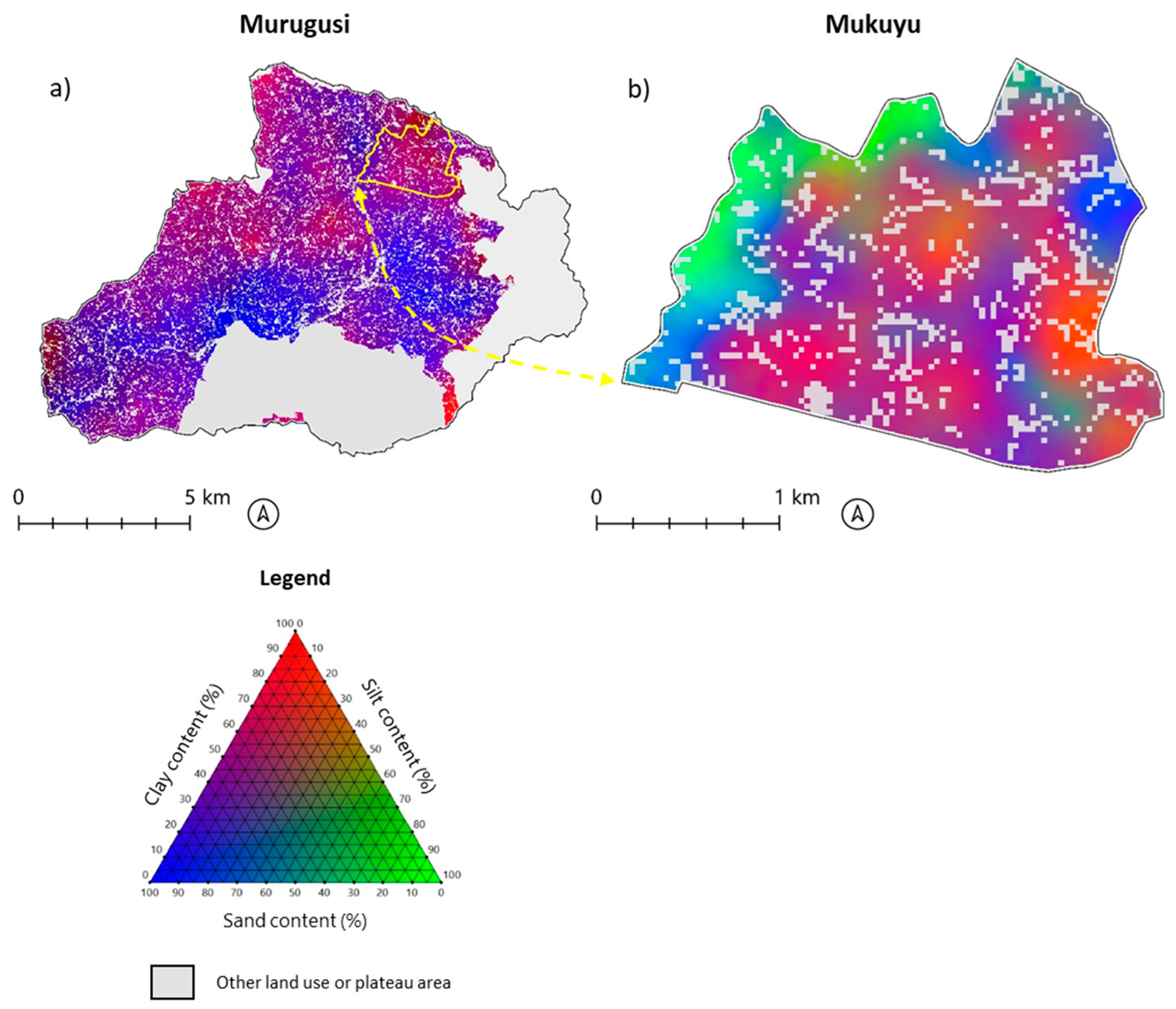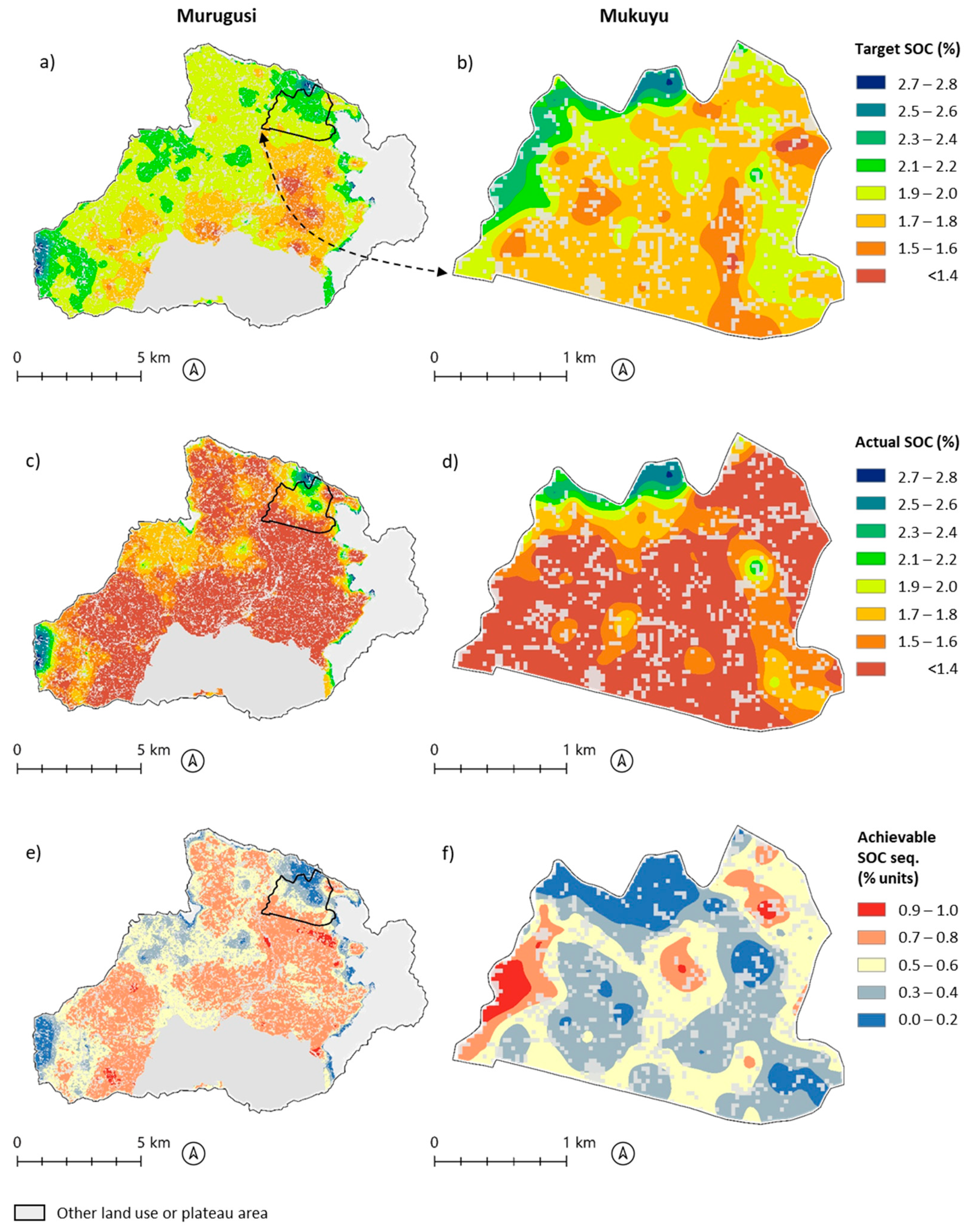A Boundary Plane Approach to Map Hotspots for Achievable Soil Carbon Sequestration and Soil Fertility Improvement
Abstract
:1. Introduction
- Introduce the concept of achievable SOC sequestration and describe it in contrast to the concept of SOC sequestration potential.
- Describe a boundary plane approach for mapping target SOC content and achievable SOC sequestration, based on datasets from soil sample analyses of texture and SOC.
- Demonstrate the method at two spatial scales: i) in a 125 km2 catchment in Western Kenya and ii) in a 4 km2 sub-area of that catchment.
- Assess the potential benefits of increasing the SOC content in terms of soil fertility by testing correlations between soil nutrient status and SOC contents within the two study areas.
2. Materials and Methods
2.1. Study Area
2.2. Soil Sampling
2.2.1. Murugusi Catchment
2.2.2. Mukuyu Sub-Area
2.3. Laboratory Analyses
2.3.1. Sample Preparation and Laboratory Facilities
2.3.2. Laboratory Analyses
2.4. Estimation Method for Achievable SOC Sequestration
2.5. A Coordinate System for Soil Texture and SOC Content
2.6. A Boundary Plane Model for Target SOC Content
2.7. Mapping of SOC Sequestration
2.8. Testing Relationships Between Other Soil Properties and SOC
2.9. SOC Stock Estimation
2.10. Software
2.11. Published Data
3. Results
3.1. Descriptive Statistics on Soil Properties
3.2. Boundary Plane Analyses
3.3. Maps
3.4. Relationships Between Other Soil Properties and SOC
3.5. SOC Stock
4. Discussion
4.1. Implications of the Study
4.2. SOC and Soil Fertility
4.3. How to Express Soil Texture?
4.4. Achievable SOC Sequestration in the Example Area(s)
5. Summary
- The concept of achievable soil SOC sequestration was developed. Achievable soil SOC sequestration is not a biophysical property of the soil but a measure of how much SOC that is realistic to sequester in an area without major changes in land use or agricultural systems.
- A boundary plane approach to model achievable soil carbon sequestration potential was described. Ideally, the method should be applied in areas that are rather homogeneous in terms of socio-economic as well as biophysical conditions. The method was demonstrated in two areas of different sizes in western Kenya.
- A higher SOC content was associated with a higher CEC and higher contents of several important nutrients in the soil, which indicates a possible improvement in soil fertility when the SOC content is raised to the modeled target levels.
Author Contributions
Funding
Acknowledgments
Conflicts of Interest
References
- Ontl, T.A.; Schulte, L.A. Soil carbon storage. Nat. Educ. Knowl. 2012, 3, 35. [Google Scholar]
- Poeplau, C.; Don, A. Carbon sequestration in agricultural soils via cultivation of cover crops—A meta-analysis. Agrecosys. Env. 2015, 200, 33–41. [Google Scholar] [CrossRef]
- West, T.O.; Six, J. Considering the influence of sequestration duration and carbon saturation on estimates of soil carbon capacity. Clim. Chang. 2007, 80, 25–41. [Google Scholar] [CrossRef]
- Status of the World’s Soil Resources (SWSR)—Main Report; Food and Agriculture Organization of the United Nations and Intergovernmental Technical Panel on Soils: Rome, Italy, 2015. Available online: http://www.fao.org/3/a-i5199e.pdf (accessed on 8 June 2019).
- Lehmann, J.; Kleber, M. The contentious nature of soil organic matter. Nature 2015, 528, 60. [Google Scholar] [CrossRef] [PubMed]
- Schlesinger, W.H.; Bernhardt, E.S. Biogeochemistry: An analysis of global change; Academic Press: Cambridge, MA, USA, 2013; 688p. [Google Scholar]
- Paustian, K.; Lehmann, J.; Ogle, S.; Reay, D.; Robertson, G.P.; Smith, P. Climate-smart soils. Nature 2016, 532, 49. [Google Scholar] [CrossRef] [PubMed]
- Smith, P. Soil carbon sequestration and biochar as negative emission technologies. Glob. Chang. Biol. 2016, 22, 1315–1324. [Google Scholar] [CrossRef] [PubMed]
- Zomer, R.J.; Bossio, D.A.; Sommer, R.; Verchot, L.V. Global sequestration potential of increased organic carbon in cropland soils. Sci. Rep. 2017, 7, 15554. [Google Scholar] [CrossRef] [PubMed]
- Castellano, M.J.; Mueller, K.E.; Olk, D.C.; Sawyer, J.E.; Six, J. Integrating plant litter quality, soil organic matter stabilization, and the carbon saturation concept. Glob. Chang. Biol. 2015, 21, 3200–3209. [Google Scholar] [CrossRef]
- Feng, W.; Plante, A.F.; Six, J. Improving estimates of maximal organic carbon stabilization by fine soil particles. Biogeochemistry 2013, 112, 81–93. [Google Scholar] [CrossRef]
- Gulde, S.; Chung, H.; Amelung, W.; Chang, C.; Six, J. Soil carbon saturation controls labile and stable carbon pool dynamics. Soil Sci Soc Am. J. 2008, 72, 605–612. [Google Scholar] [CrossRef]
- Beare, M.H.; McNeill, S.J.; Curtin, D.; Parfitt, R.L.; Jones, H.S.; Dodd, M.B.; Sharp, J. Estimating the organic carbon stabilisation capacity and saturation deficit of soils: A New Zealand case study. Biogeochemistry 2014, 120, 71–87. [Google Scholar] [CrossRef]
- McNally, S.R.; Beare, M.H.; Curtin, D.; Meenken, E.D.; Kelliher, F.M.; Calvelo Pereira, R.; Shen, Q.; Baldock, J. Soil carbon sequestration potential of permanent pasture and continuous cropping soils in New Zealand. Glob. Chang. Biol. 2017, 23, 4544–4555. [Google Scholar] [CrossRef] [PubMed]
- Hassink, J. The capacity of soils to preserve organic C and N by their association with clay and silt particles. Plant. Soil 1997, 191, 77–87. [Google Scholar] [CrossRef]
- Webb, R.A. Use of the boundary line in the analysis of biological data. J. Hortic. Sci. 1972, 47, 309–319. [Google Scholar] [CrossRef]
- Davis, R.O.E.; Bennett, H.H. Grouping of soils on the basis of mechanical analysis. USA: U.S. Dept. of Agriculture 1927. Available online: https://naldc-legacy.nal.usda.gov/naldc/download.xhtml?id=CAT87217164&content=PDF (accessed on 8 June 2019).
- Akpa, S.I.; Odeh, I.O.; Bishop, T.F.; Hartemink, A.E.; Amapu, I.Y. Total soil organic carbon and carbon sequestration potential in Nigeria. Geoderma 2016, 271, 202–215. [Google Scholar] [CrossRef]
- Chambers, A.; Lal, R.; Paustian, K. Soil carbon sequestration potential of US croplands and grasslands: Implementing the 4 per Thousand Initiative. J. Soil Water Conserv. 2016, 71, 68A–74A. [Google Scholar] [CrossRef] [Green Version]
- Lugato, E.; Bampa, F.; Panagos, P.; Montanarella, L.; Jones, A. Potential carbon sequestration of European arable soils estimated by modelling a comprehensive set of management practices. Glob. Change Biol. 2014, 20, 3557–3567. [Google Scholar] [CrossRef] [Green Version]
- Minasny, B.; Malone, B.P.; McBratney, A.B.; Angers, D.A.; Arrouays, D.; Chambers, A.; Chaplot, V.; Chen, Z.-S.; Cheng, K.; Das, B.S.; et al. Soil carbon 4 per mille. Geoderma 2017, 292, 59–86. [Google Scholar] [CrossRef]
- Wiesmeier, M.; Hübner, R.; Spörlein, P.; Geuß, U.; Hangen, E.; Reischl, A.; Schilling, B.; von Lützow, M.; Kögel-Knabner, I. Carbon sequestration potential of soils in southeast Germany derived from stable soil organic carbon saturation. Glob. Change Biol. 2014, 20, 653–665. [Google Scholar] [CrossRef]
- IUSS Working Group WRB. World Reference Base for Soil Resources 2014. International Soil Classification System for Naming Soils and Creating Legends for Soil Maps; World Soil Resources Reports, 106; FAO: Rome, Italy, 2014; 203p, Available online: http://www.fao.org/3/i3794en/I3794en.pdf (accessed on 8 June 2019).
- Wandere, D.O.; Egesah, O.B. Comparative ecological perspectives on food security by Abanyole of Kenya. Int. J. Ecol. Ecosolution. 2015, 2, 22–30. [Google Scholar]
- Mavuthu, A.K. Effect of the National Accelerated Agricultural Inputs Access Subsidy Program on Fertilizer Usage and Food Production in Kakamega County, Western Kenya. Ph.D. Thesis, Walden University, Minneapolis, MN, USA, May 2017. Available online: https://scholarworks.waldenu.edu/cgi/viewcontent.cgi?article=4906&context=dissertations (accessed on 8 June 2019).
- Ndwiga, J.; Pittchar, J.; Musyoka, P.; Nyagol, D.; Marechera, G.; Omanya, G.; Oluoch, M. Constraints and Opportunities of Maize Production in Western Kenya: A Baseline Assessment of Striga Extent, Severity, and Control Technologies; International Institute of Tropical Agriculture (IITA): Ibadan, Nigeria, 2013. [Google Scholar]
- Odeh, I.O.A.; McBratney, A.B.; Chittleborough, D.J. Further results on prediction of soil properties from terrain attributes: Heterotopic cokriging and regression-kriging. Geoderma 1995, 67, 215–226. [Google Scholar] [CrossRef]
- Estefan, G.; Sommer, R.; Ryan, J. Analytical Methods for Soil-Plant. and Water in Dry Areas. A Manual of Relevance to the West. Asia and North. Africa Region, 3rd ed.; International Center for Agricultural Research in the Dry Areas: Aleppo, Syria, 2013; 255p, Available online: http://repo.mel.cgiar.org:8080/handle/20.500.11766/7512?show=full (accessed on 8 June 2019).
- Mehlich, A. Mehlich 3 soil test extractant: A modification of Mehlich 2 extractant. Commun. Soil Sci. 1984, 15, 1409–1416. [Google Scholar] [CrossRef]
- Hastie, T.; Tibshirani, R.; Friedman, J. The Elements of Statistical Learning; Springer: New York, NY, USA, 2009; p. 745. Available online: https://web.stanford.edu/~hastie/Papers/ESLII.pdf (accessed on 8 June 2019).
- R Core Team. R: A language and environment for statistical computing. R Foundation for Statistical Computing; R Foundation for Statistical Computing: Vienna, Austria, 2018; Available online: https://www.R-project.org/ (accessed on 8 June 2019).
- Piikki, K.; Söderström, M.; Sommer, R.; Da Silva, M. Physical topsoil properties in Murugusi, Western Kenya; Harvard University: Cambridge, MA, USA, 2019. [Google Scholar] [CrossRef]
- Aune, J.B.; Lal, R. Agricultural productivity in the tropics and critical limits of properties of Oxisols, Ultisols and Alfisols. Trop. Agr. 1997, 74, 96–103. [Google Scholar]
- Loveland, P.; Webb, J. Is there a critical level of organic matter in the agricultural soils of temperate regions: A review? Soil Tillage Res. 2003, 70, 1–18. [Google Scholar] [CrossRef]
- Piikki, K.; Winowiecki, L.; Vågen, T.G.; Ramirez-Villegas, J.; Söderström, M. Improvement of spatial modelling of crop suitability using a new digital soil map of Tanzania. South Afr. J. Plant. Soil 2017, 34, 243–254. [Google Scholar] [CrossRef]






| Soil Property | Murugusi (n = 102) | Mukuyu (n = 235) | ||||||||
|---|---|---|---|---|---|---|---|---|---|---|
| Min | Q1 | Q2 | Q3 | Max | Min | Q1 | Q2 | Q3 | Max | |
| SOC (%) | 0.8 | 1.1 | 1.3 | 1.6 | 3.7 | 0.6 | 1.2 | 1.3 | 1.5 | 3.0 |
| Clay (%) | 13 | 25 | 29 | 34 | 47 | 14 | 30 | 35 | 39 | 54 |
| Sand (%) | 29 | 55 | 60 | 67 | 82 | 29 | 52 | 56 | 62 | 82 |
| Silt (%) | 4 | 6 | 10 | 13 | 36 | 2 | 6 | 8 | 10 | 32 |
| pH | 4.6 | 5.2 | 5.5 | 5.9 | 7.6 | 4.4 | 5.2 | 5.4 | 5.8 | 8.2 |
| P (ppm) | 3.7 | 10.6 | 14.9 | 25.6 | 61.9 | 1.5 | 8.6 | 13.2 | 23.2 | 130.0 |
| K (ppm) | 21 | 85 | 122 | 215 | 794 | 20 | 83 | 119 | 168 | 1150 |
| Ca (ppm) | 119 | 486 | 731 | 1158 | 3600 | 150 | 548 | 767 | 1125 | 6040 |
| Mg (ppm) | 34 | 82 | 119 | 162 | 662 | 23 | 91 | 118 | 172 | 582 |
| S (ppm) | 0.3 | 9.1 | 11.4 | 13.7 | 43.8 | 0.5 | 7.6 | 9.8 | 12.6 | 24.5 |
| Fe (ppm) | 57 | 95 | 114 | 136 | 500 | 60 | 127 | 144 | 205 | 572 |
| B (ppm) | 0.0 | 0.1 | 0.1 | 0.2 | 1.0 | 0.0 | 0.1 | 0.2 | 0.3 | 2.5 |
| Mn (ppm) | 5 | 51 | 73 | 113 | 298 | 6 | 51 | 72 | 101 | 291 |
| Zn (ppm) | 0.1 | 0.7 | 1.2 | 1.9 | 12.3 | 0.5 | 1.3 | 2.0 | 3.0 | 30.6 |
| Cu (ppm) | 0.7 | 1.2 | 1.5 | 1.8 | 10.2 | 0.9 | 1.7 | 2.0 | 2.5 | 12.2 |
| CEC (cmolc kg−1) | 2.8 | 6.5 | 8.4 | 10.4 | 31.0 | 2.1 | 7.0 | 8.4 | 10.9 | 36.8 |
| BD (g cm−3) | 0.9 | 1.2 | 1.3 | 1.4 | 1.5 | - | - | - | - | - |
| Area | i | j | k | MAE (% SOC) |
|---|---|---|---|---|
| Murugusi | 3 *** | −30 *** | 11 *** | 0.2 |
| Mukuyu | 3 *** | −37 *** | 16 *** | 0.2 |
© 2019 by the authors. Licensee MDPI, Basel, Switzerland. This article is an open access article distributed under the terms and conditions of the Creative Commons Attribution (CC BY) license (http://creativecommons.org/licenses/by/4.0/).
Share and Cite
Piikki, K.; Söderström, M.; Sommer, R.; Da Silva, M.; Munialo, S.; Abera, W. A Boundary Plane Approach to Map Hotspots for Achievable Soil Carbon Sequestration and Soil Fertility Improvement. Sustainability 2019, 11, 4038. https://doi.org/10.3390/su11154038
Piikki K, Söderström M, Sommer R, Da Silva M, Munialo S, Abera W. A Boundary Plane Approach to Map Hotspots for Achievable Soil Carbon Sequestration and Soil Fertility Improvement. Sustainability. 2019; 11(15):4038. https://doi.org/10.3390/su11154038
Chicago/Turabian StylePiikki, Kristin, Mats Söderström, Rolf Sommer, Mayesse Da Silva, Sussy Munialo, and Wuletawu Abera. 2019. "A Boundary Plane Approach to Map Hotspots for Achievable Soil Carbon Sequestration and Soil Fertility Improvement" Sustainability 11, no. 15: 4038. https://doi.org/10.3390/su11154038





